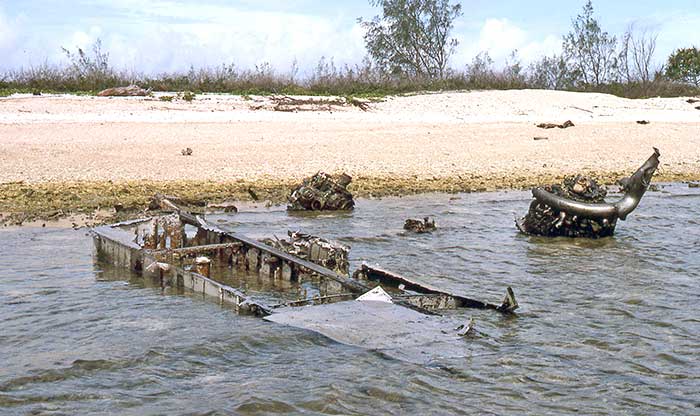RAAF flying boats sold as scrap from RAAF Lake Boga, Victoria after the Second World War
Compiled by Geoff Goodall
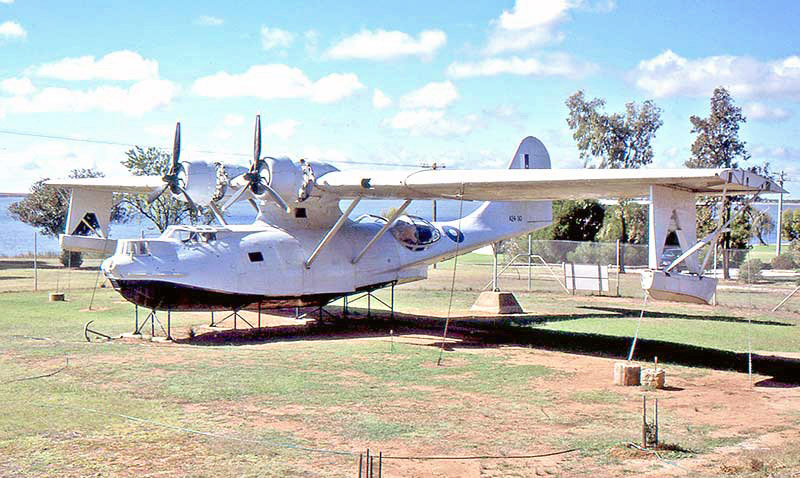
in 1999, soon after it was displayed on the site of the former
RAAF Station. Photo by Nigel Daw
A second repair base was established at RAAF Rathmines on Lake Macquarie, north of Sydney, which had been a flying boat base since 1939. No.2 FBRD at Rathmines worked in association with 1FBRD for the duration of the war, although Lake Boga received the majority of flying boats for repair, rebuilds and routine major overhauls. These included RAAF, Netherlands and United States aircraft. For a detailed history of RAAF Lake Boga, the book Lake Boga At War by Brett Freeman (Catalina Publications, Swan Hill 1995) is highly recommended.
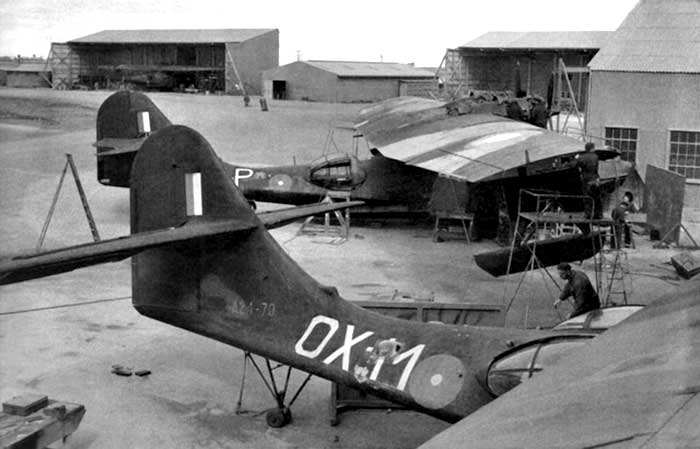
Photo: Australian War Memorial collection
Civil Registered Catalinas in Australia Part 1 on this site includes a listing of post-war RAAF Catalina sales from Lake Boga by the Commonwealth Disposals Commission, some going on to civil flying careers.
This article looks at the Catalinas that were left behind, unsold and unwanted, which were passed on to the Department of Aircraft Production for disposal. DAP had tried various methods of destroying groups of aircraft at other RAAF stations - for example a costed experiment held at RAAF Evans Head burning Fairey Battles and burying the remains, which showed the cost manpower and excavating equipment was too high. So DAP settled for a new round of disposals sales at RAAF stations across Australia during 1947-1949, offering aircraft, aero engines and equipment as scrap metal, or for sale at token prices to local citizens as "aircraft remnants" (the official term for aircraft stripped of parts, weathered from years parked in the open). Many farmers bid for these aircraft and towed them home behind tractors, to probvide sheet metal skinning, perspex panels, electrical wiring and light globes, engines and numerous other parts of use on the farm during those austere postwar rationing years. For more details, refer Ansons and Oxfords on SA Farms also on this site.
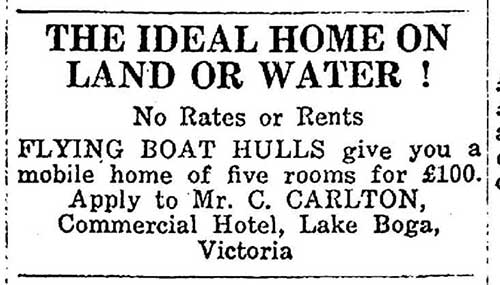
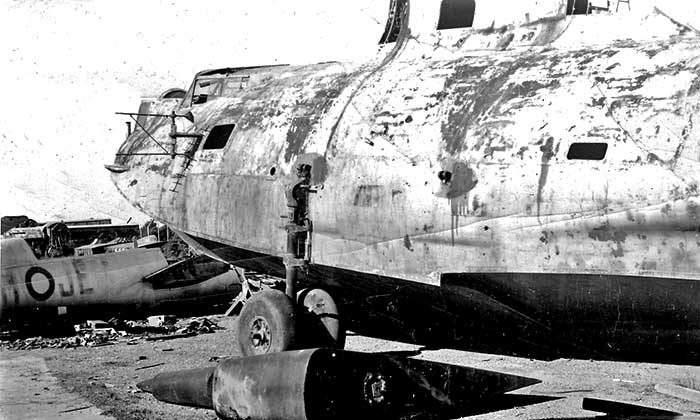
Lake Boga circa 1950 after the scrap metal merchants had moved in. A Catalina fuselage on its beaching gear
and RAAF Vought-Sikorsky Kingfisher fuselages stacked behind. Photo: Rod Adam collection
and RAAF Vought-Sikorsky Kingfisher fuselages stacked behind. Photo: Rod Adam collection
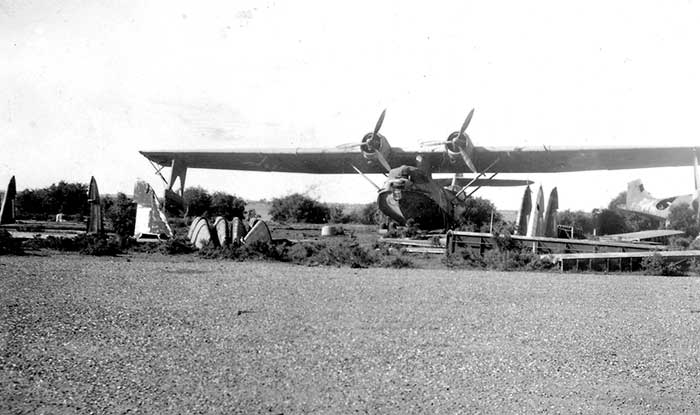
Tails and wing sections are stacked in the foreground. Photo: Rod Adam collection
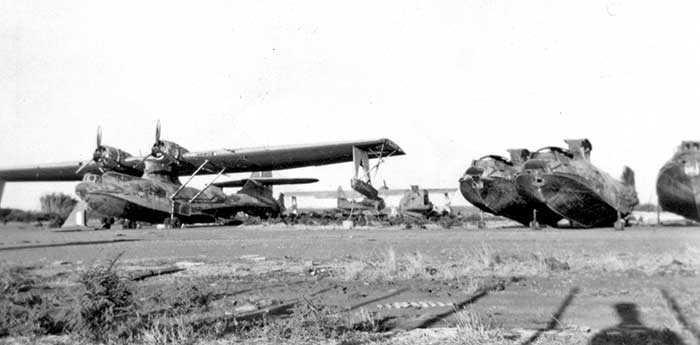
Photo: David Vincent collection
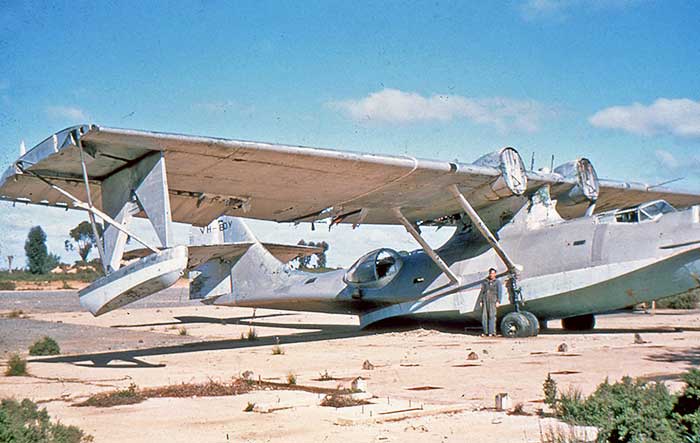
There it was sold as scrap metal. Nigel Daw collection
The Lake Boga Flying Boat Museum has established an impressive display, now with a large hangar for the Catalina and a Dornier Do 24 nose section. Once the Catalina was moved inside the new building, it was given a professional repaint in 2011 by a team from Historical Aircraft Restoration Society, Albion Park NSW. This was part of a HARS deal in which the authentic rear fuselage blisters were removed from "A24-30" and loaned to HARS as patterns to fabricate new blisters for their airworthy PBY-6A VH-PBZ. When the original blisters were re-installed on the Lake Boga Catalina, HARS then repainted the entire aircraft, retaining the serial "A24-30".
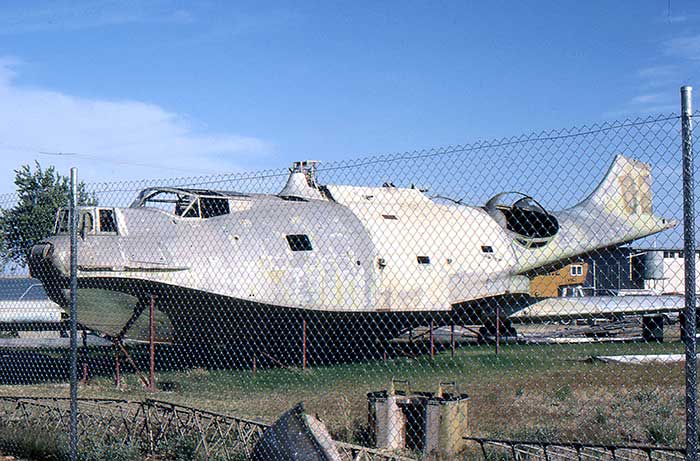
Photo by Nigel Daw
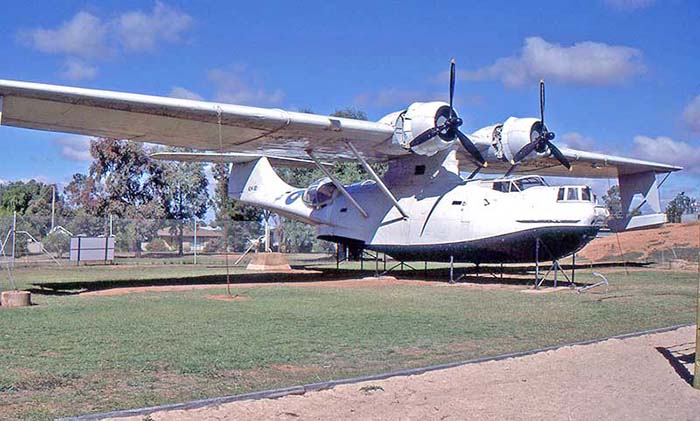
Timber barges on the River Murray
An unknown number of Catalina fuselages were acquired by the timber traders from scrap metal merchants chopping up aircraft at the closed RAAF Lake Boga during the late 1940s and into the early 1950s. The fuselages were cut down to make open barges and some had marine engines installed so they could make their own way to the timber mills on the river.
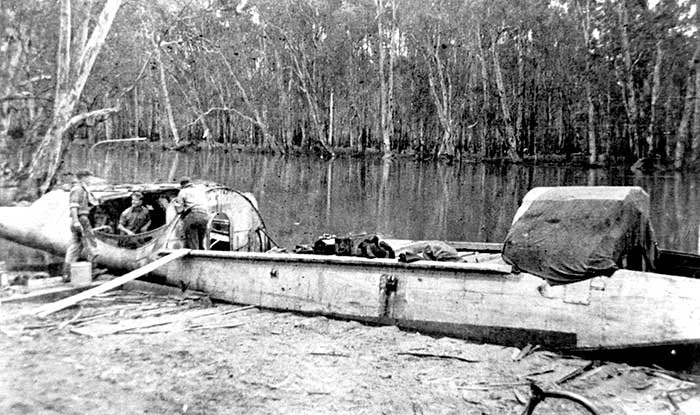
This one has an engine and steering gear fitted. Photos: David Vincent collection
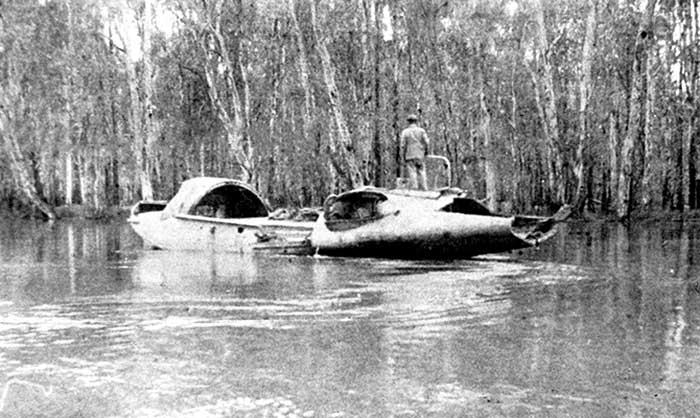
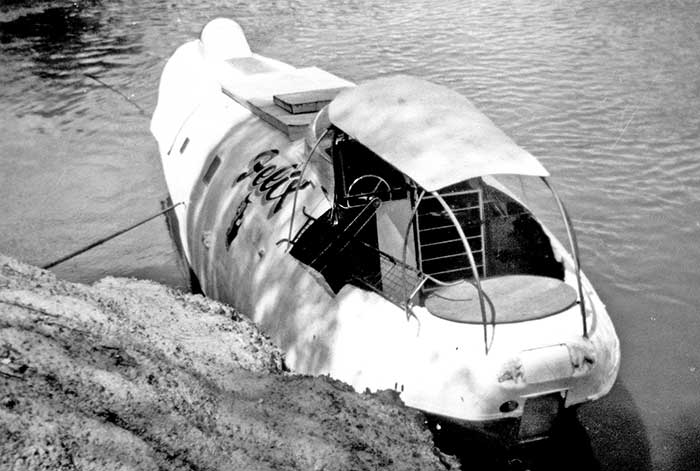
Photo by Rob Fox
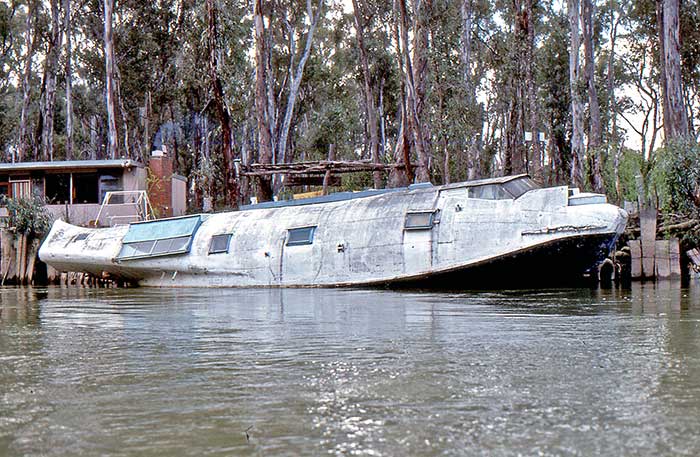
which identified it as A24-88 which had been a 42 Squadron "Black Cat" RK-A which took part in the secret
long range mission to drop mines in Manila harbour in December 1944. Photo by Nigel Daw
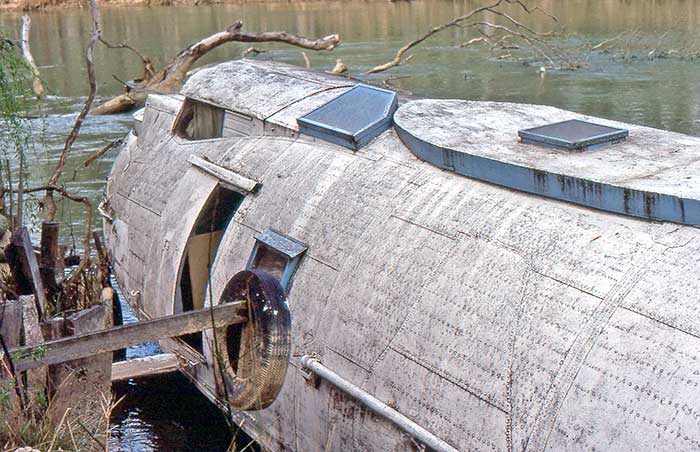
acquired by Australian National Aviation Museum at Moorabbin Airport, Melbourne. It is being restored
with blisters as RAAF Black Cat "RK-A" and will be mated with a mainplane acquired from USA
Photo by Nigel Daw
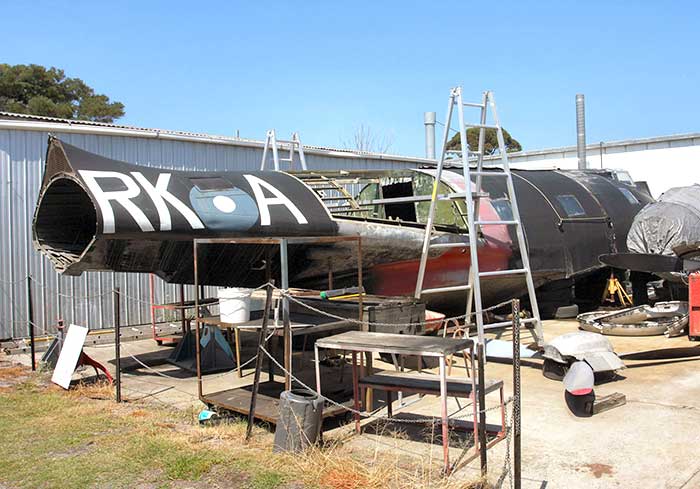
Photo by Ian McDonell
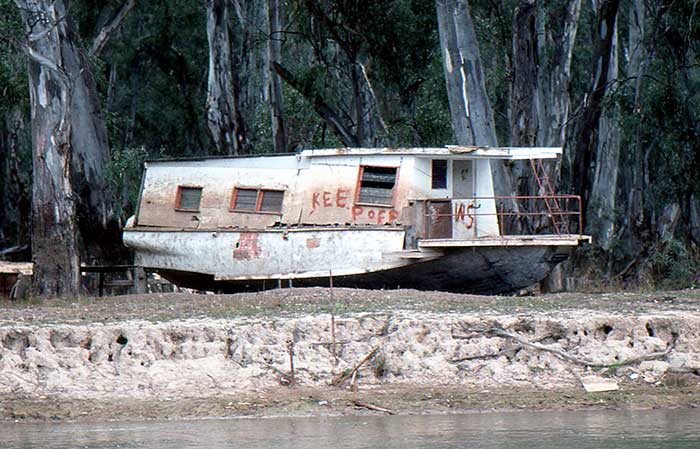
Photo by Nigel Daw
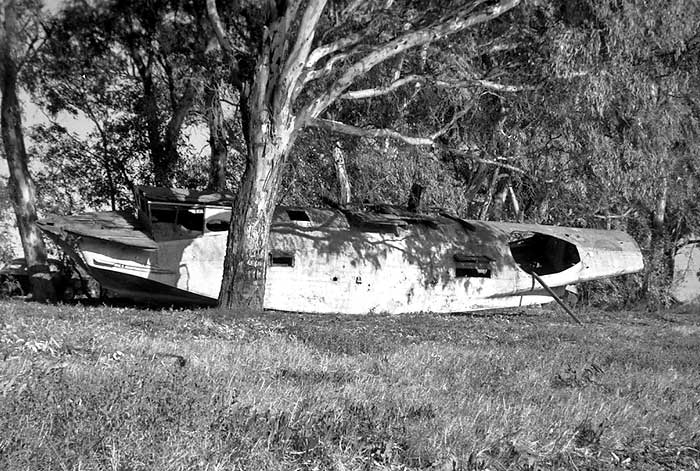
Photo by Geoff Goodall
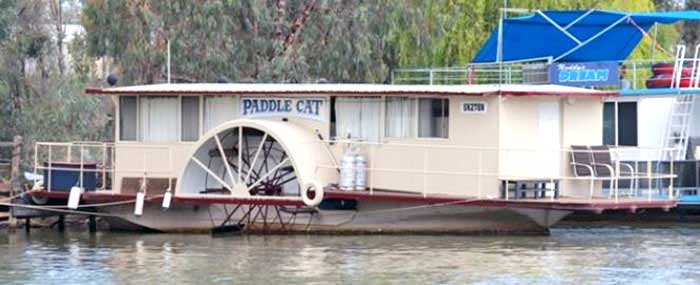
On a block in the town a small collection of Catalina airframe parts were found, including armour plating and a tailplane section clearly showing RAAF serial A24-46. However this Catalina's fuselage sections were salvaged from a farm by Warbirds Aviation Museum at Mildura. To add to the river cruise experience, the proprietors installed mock paddle wheels on each side.
The following set of photographs were taken by Dave Eyre, who watched its progress during visits to Wentworth.
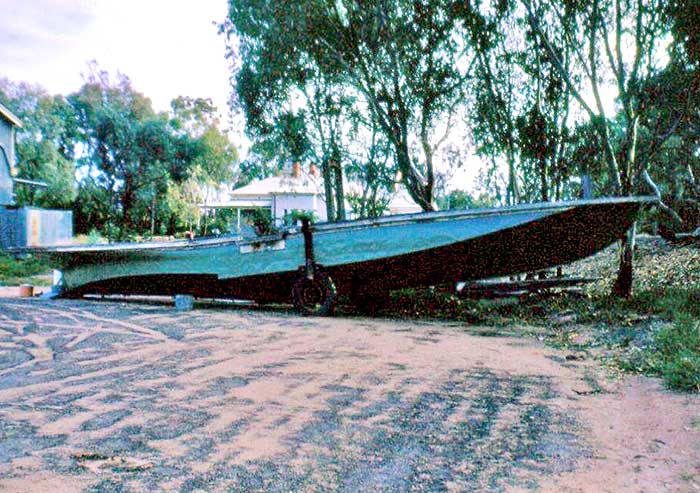
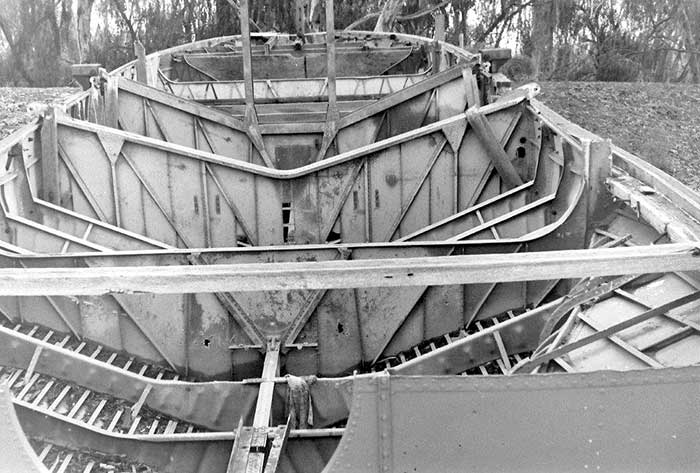
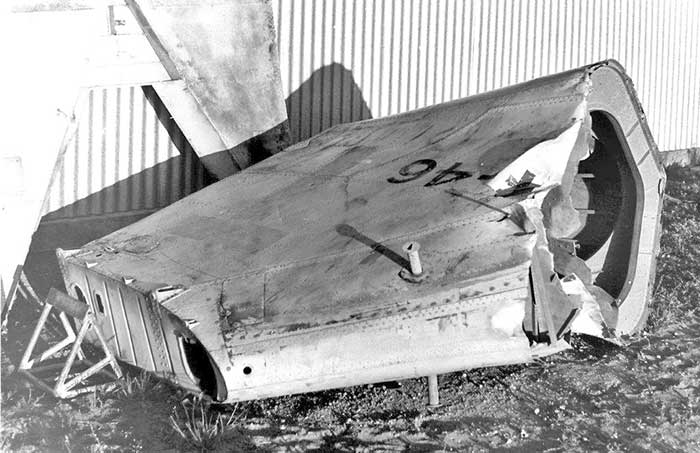
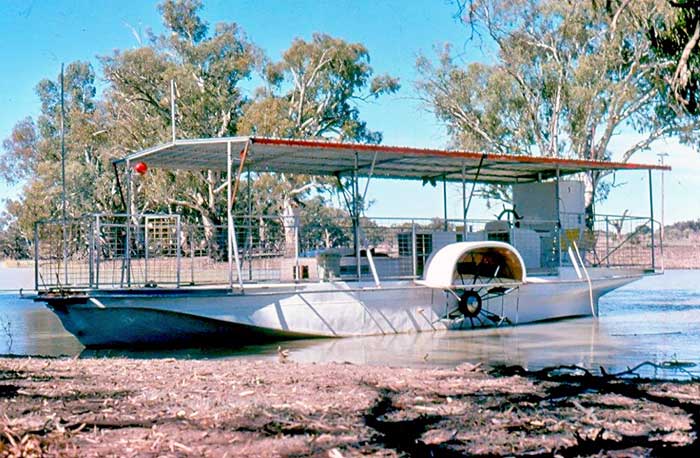
OTHER LAKE BOGA CATALINA REMAINS
Catalina fuselages on their beaching gear were towed home from Lake Boga by farmers in northern Victoria. Some took wing sections to strip off the metal skinning to make sheds and fences on their properties. Catalina remains have been found on farms as far away as Nyah West and Pyramind Hill.
Warbirds Aviation Museum at Mildura Vic recovered much of the airframe of A24-46 from a farm near Lake Boga in the early 1970s. The tailplane had a yellow "T" over the camouflage. The sections were held in storage by the museum and no significant restoration work was attempted. The nose section forward of the cockpit was displayed in the museum compound - all the RAAF paintwork had worn away due weather exposure, revealing the original factory US Navy finish.
In 1987 John Bell, a commercial pilot from Albany WA with a strong interest in aviation history, particularly military seaplanes, came to an agreement with the museum to acquire the incomplete Vought Kingfisher floatplane A48-2 and the fuselage sections of A24-46. He collected the Kingfisher first, followed by the Catalina in 1989, both having long road trips to Albany WA. There John had been involved in the establishement of the Whaleworld museum on the site of the closed Cheynes Beach Whaling Company, for whom he had flown Cessna floatplanes for whale spotting. He assembled the Kingfisher and Catalina fuselage inside the museum building.
Tragically John Bell was killed on 13 March 1996 when his Cessna 337 struck terrain near Albany while on a low level police surveillance operation. Whaleworld's fortunes were to suffer and the museum closed down, its contents being auctioned in June 2004. As well as the Catalina fuselage and Kingfisher, the auction included a whale-spotting Cessna 172 floatplane display and John's other restoration project, ex RAAF Vultee Vengeance A27-247 salvaged from a Kalgoorlie scrap metal yard. The Catalina fuselage was moved by road 50 km to a property near Denmark WA, where its owner Bruce Galash continues the restoration to wartime configuration.
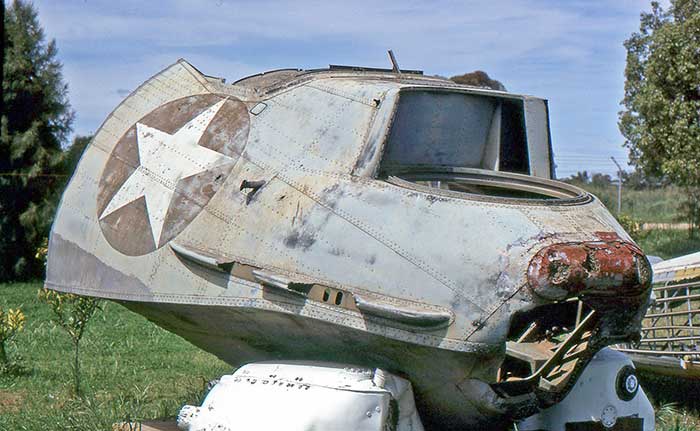
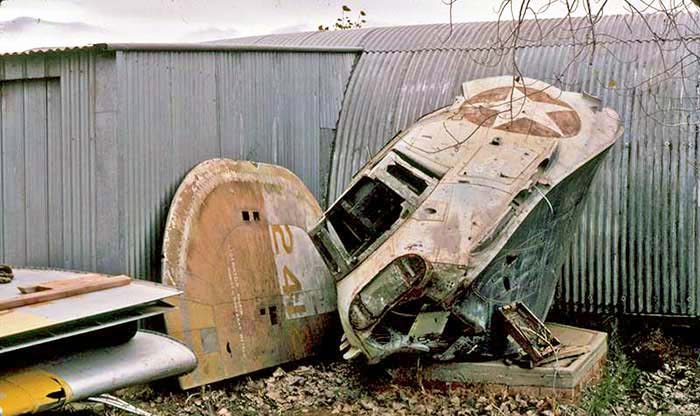
with stacked Wirraway wings and a B-24 tailplane. Photo by Geoff Goodall
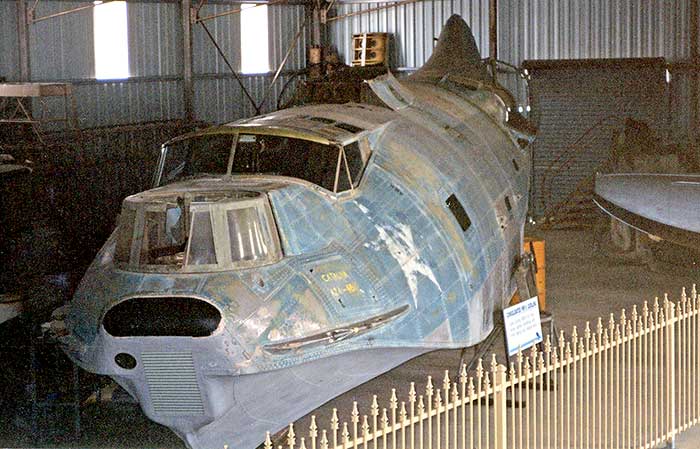
Photo by John Chapman
It was reportedly wrecked when blown over by a wind storm in the early 1990s.
A24-19 was another of the Catalinas purchased at the Lake Boga disposals sales by Kingsford Smith Aviation Services, Sydney. They were acquired only for their engines, instruments and parts. The stripped airframes were left behind as scrap, many re-sold to farmers.

Photo by Bruce McAllister via Nigel Daw collection
Commonwealth Disposals Commission was delayed at the request of the RAAF Antarctic Flight, which was preparing a Kingfisher at Rathmines to be evaluated on the next Antarctic expedition. The Flight requested that the Lake Boga Kingfishers be held in reserve, even though six of the seven were without their P&W R-985 engines.
Meanwhile Mr. Norman Padgett of Werribee Victoria was eager to acquire a Kingfisher. This experienced pre-war airline pilot and adventurer had an eventful RAAF wartime career, being awarded the Air Force Medal for his courage under fire in New Guinea. Following his discharge from RAAF in 1946, Padgett established a timber mill on a river in Borneo, flying his Anson VH-BAV to Borneo and return twice before purchasing a Navy disposals 70 feet general-purpose launch, on which he planned to carry a Kingfisher to the mill.
He had offered the CDC £400 for a Kingfisher and A48-2 with engine had been allocated, but within days withdrawn due to the Antarctic Flight request. Undeterred, Padgett met with senior RAAF officers, resulting in no less than Air Chief Marshall Frederick Scherger supporting his request for one of the engineless Kingfishers at Lake Boga be released to him. This was approved and on 2.6.47 CDC sold him A48-5 without an engine for a reduced price £275. Padgett had purchased a serviceable R-985 from another CDC sale and transported it to Lake Boga, where he installed it in A48-5, test flew it on the lake then departed for Melbourne where he landed at Williamstown boat harbour. A48-5 was flown by Norman Padgett without civil registration off rivers in Borneo for the next four years.
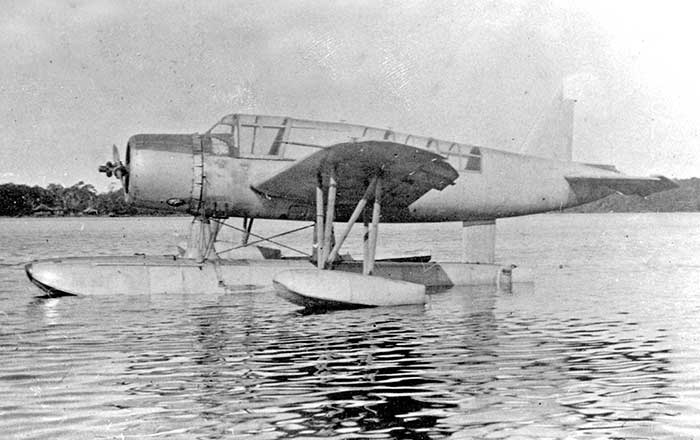
Only one of these has been located. The fuselage, tailplane and floats of A48-2 were acquired from a scrap metal dealer by George Kremor and moved to his fruit orchard at Merbein near Mildura. He cut open the smaller wingtip floats to make single-man canoes. In 1967 the remains were found by Pearce Dunn who was establishing his Warbirds Aviation Museum at Mildura Airport.
Having acquired the mortal remains of A48-2, Pearce carried out some cosmetic restoration of the fuselage in the museum compound. In 1987 he agreed to sell the Kingfisher components and unrestored fuselage sections of Catalina A24-46 to John Bell of Albany WA. Both were moved by road to Albany where John reassembled them in the Waleworld museum.
Over following years, John Bell tracked down some of the airframe parts he needed to complete the Kingfisher : inspecting the yard of an elderly Singapore scrap dealer who had shipped wartime aircraft wrecks from Borneo, including Norman Padgett's A48-5 abandoned on a beach at Labuan. John also visited US aircraft parts dealers and even to Chile to follow up reports of remaining parts from Chilean Air Force Kingfishers.
Following John's death in a plane crash in March 1996, Whaleworld suffered a decline and was later forced to close. Its contents were auctioned in June 2004. John's Kingfisher and Vultee Vengeance were purchased by warbird restoration specialists Precision Aerospace Productions Pty Ltd and moved by road to their maintenance base at Wangaratta Airport, Victoria. There it was to be rebuilt to airworthy for US warbird collector Gerald Yagen of Virginia Beach Virginia. Yagen had acquired a Kingfisher hulk, which he shipped to Australia for use as a pattern. Metal work began on the rebuild at Wangaratta. Precision Aerospace applied to CASA to register the aircraft and on 10 February 2012 A48-2 was registered as VH-PSG. Inexplicably, its identity was quoted as "A48-7", which crashed into Lake Macquarie and sank in December 1943.
Things were looking promising for the world's only potential flying Vought Sikorsky Kingfisher when fate stepped in again. The founder of Precision Aerospace Productions died unexpectedly and his warbird restoration operation soon shut down. The business was later taken over by local warbird owner Doug Hamilton, but Yagen had moved the Kingfisher project to Auckland NZ to warbird restorers Pioneer Aero Ltd.
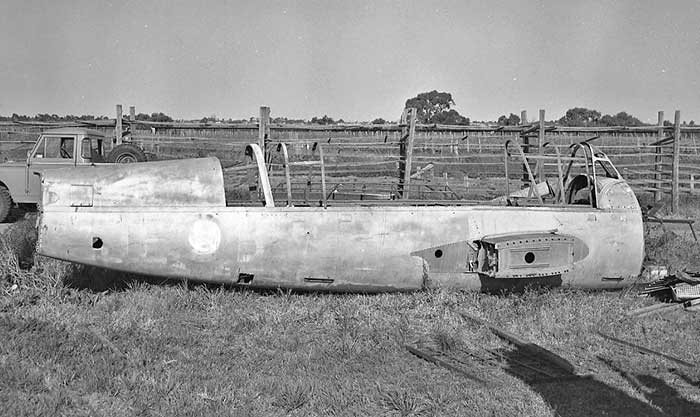
code "JE-B"is etched in the metal with the roundel. Photo by Geoff Goodall
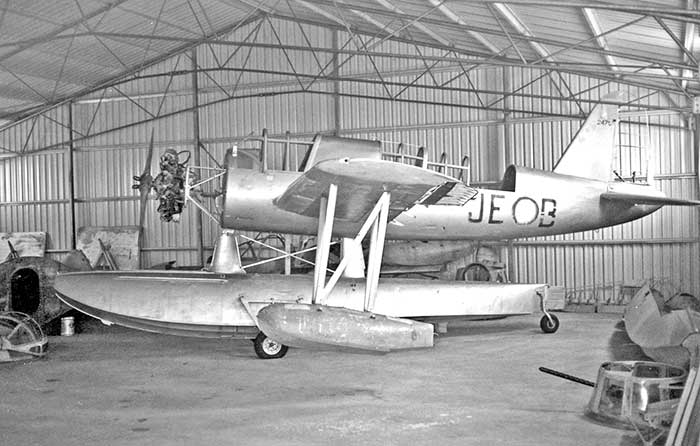
Photo by John Chapman
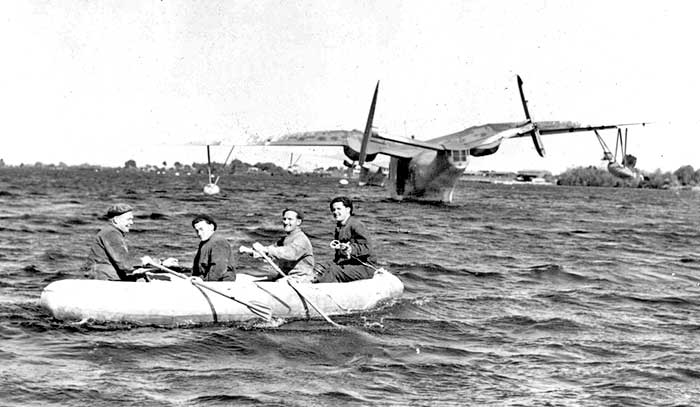
Photo: State Library of Victoria
No RAAF Mariners were lost in service, and all 12 were ferried to Lake Boga for retirement during 1945-46. Under the Lend Lease terms they could not be sold to civil operators, so once RAAF agreed it had no further use for them, the Mariners were handed to Department of Aircraft Production for disposal as "aircraft remnants". They were sold at Lake Boga for token prices to local farmers and scrap metal dealers. Complete Mariner fuselages, running on the wheels of their beaching gear, were towed away behind tractors and trucks to farms, where their large size provided big sections of metal skinning for fencing and sheds and generous lengths of electrical wiring.

Photo: Richard Hourigan collection
Marivan Caravans
One was A70-3 whose fuselage was hauled away from Lake Boga by Mr. T. Leed of Pyramid Hill, Victoria. When he completed making the nose into a Marivan, he painted it with the name "Pyramid Hill", and sold the rest of the airframe as scrap metal. He towed his Maravan to various distant locations around Australia on family holidays. On 24 January 1963 it was spotted being towed through Adelaide before setting off across the Nullabor Plain to Perth. The chassis of the Marivan failed near Southern Cross WA where Mr. Leeds was forced to abandon it. After repair it was acquired by Mr. M. Innocent of Pingelly WA, then Harry Bingham of Corrigin WA and by 1970 was with Ken Stephens at Doodlakine WA. In 1975 it was donated to the RAAF Association in Perth to add to their aircraft and relics collection for their proposed museum, which was established as the Aviation Heritage Museum of WA. The Marivan was towed from Doodlakine to Perth behind a museum group member's car in December 1975 and stored for a few years before a mutually-agreeable loan was negotiated with the Sport Aircraft Association of WA, who were developing their own airfield in scrub land at Serpentine, 60 Km south of Perth. It was used by President Charlie Urwin so he and his family could comfortably stay the night at the remote airfield site. Now painted with the name "The Ancient Mariner", it was a regular sight at Serpentine, parked in the shade of trees, until returned to the museum, its last trip being towed from Serpentine to the Aviation Heritage Museum, Perth in October 2002.

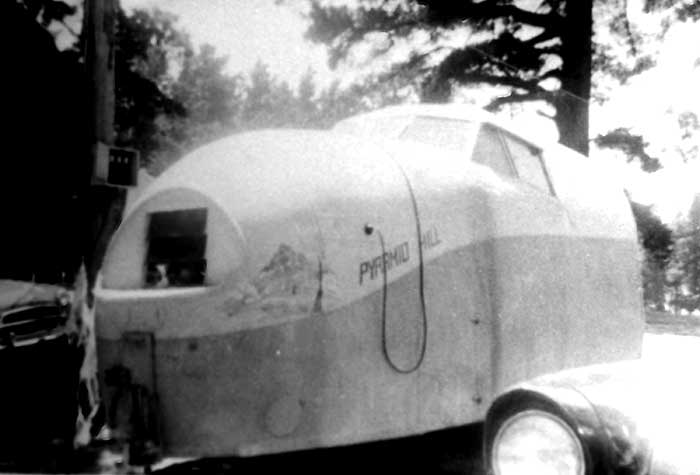
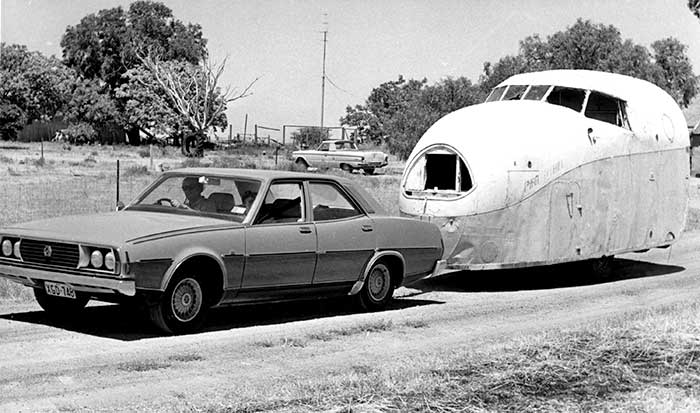
Ted Fletcher tows the Marivan "Pyramid Hill" from its resting place at Doodlakine WA in December 1975
when acquired by the RAAF Association museum group in Perth. Photo by Merv Prime
when acquired by the RAAF Association museum group in Perth. Photo by Merv Prime
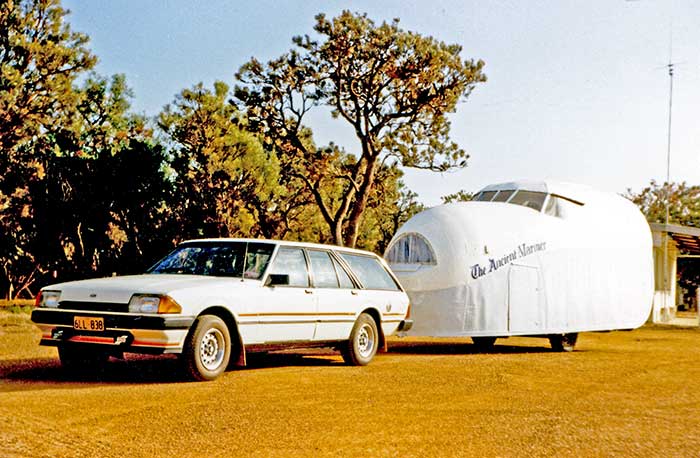
Photo: Charlie Urwin
During 1985 this Marivan appeared at the newly-formed Eureka Aviation Museum at Ballarat Airport Vic. It was painted green with the same waving line as in the picture below, but appeared to have been repainted relatively recently. The museum was later renamed Ballarat Aviation Museum and the Marivan remained in the museum hangar until last reported in 2003. It subsequent fate is not known.
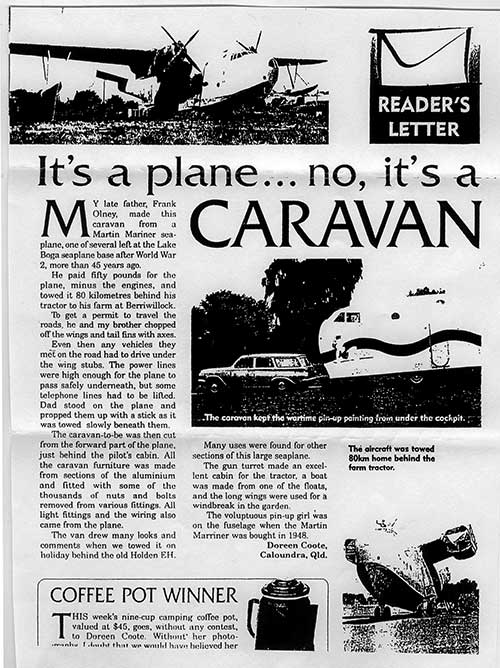
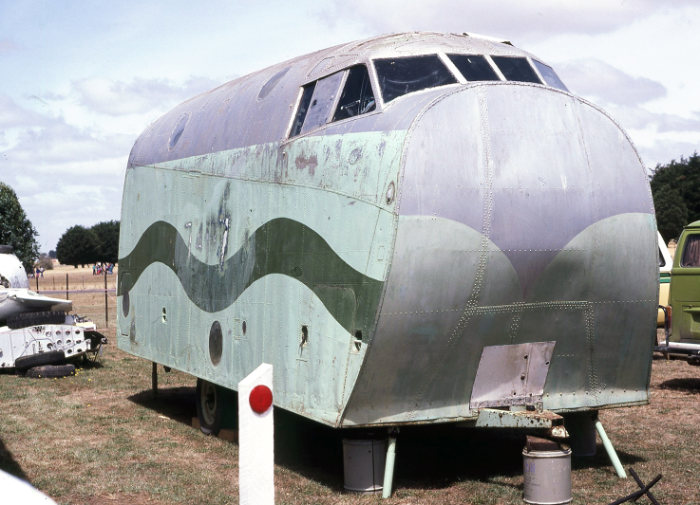
Photo by Geoff Goodall
- A70-1 complete fuselage was towed on its beaching gear from Lake Boga in 1948 to a farm near Swan Hill Vic. Little was stripped from the fuselage and in 1956 it was towed behind a tractor to another property. Serial A70-1 and the Pacific theatre RAAF blue-white roundel could still be seen on the faded camouflage, plus code letter "A", from its wartime transport radio callsign VHCOA.
- A70-12 was sold to Mr. Angelo Riggonie, of Gunbower Vic, who towed the wingless fuselage home on its beaching gear in 1948. At his farm it was broken up and stripped of useful components over the folllowing years. In 1969 Pearce Dunn was establishing his Warbirds Aviation Museum at Mildura and following up reports of wartime aircraft remains. He visited Mr. Riggonie's property later that year, by which time there was little left of A70-12. Pearce collected the rear fuselage section and parts and moved them to his museum compound on the foundations of the wartime 2OTU buildings at Mildura Airport.
By 1990 Warbirds was closing and offering many of its aircraft and parts for sale. The Mariner rear fuselage section, still showing serial "A70-12" was acquired by David Braham, Adelaide. It was moved by road from Mildura to Adelaide for Brabham by Adelaide wartime aircraft parts collector John Boden and his son John, who stored it on his property for some years. In 1998 Brabham disposed of it to a museum group at Goolwa SA who moved it to Goolwa airfield where it was left in the grass. The proposed museum did not evantuate and in 2011 the tail section was removed from Goolwa airfield by persons unknown.

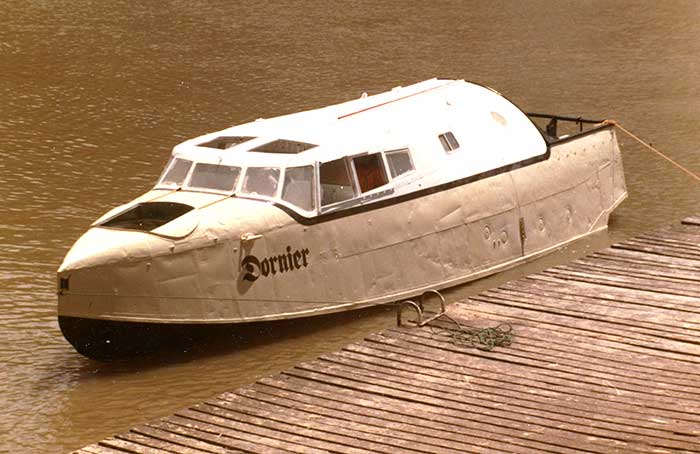
Catalina wrecks do show up in unexpected places.
In 1990 I literally trod on this submerged USN PBY-5 at a deserted beach on Princess Charlotte Bay, 500 miles north of Cairns. It happened during a picnic ashore for passengers of a coastal ship operating between Cairns and Thursday Island. Later, as the tide dropped, an aircraft wing and two radial engines became exposed. The ship's captain, who had long experience on this coastal run, said it was a US Navy Black Cat which had been washed ashore and wrecked in a storm during the war.
